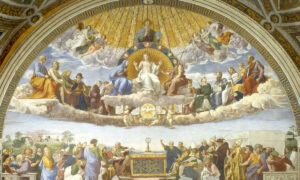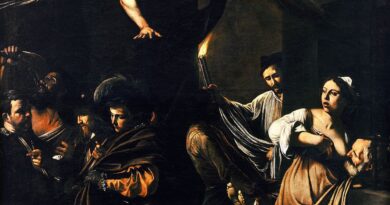Solemnity of the Most Holy Body and Blood of Christ
Massimo Palombella

In Sermon 2 of the Ascension, St Leo the Great writes: “the Son of Man made himself known in the most sublime and holiest manner as the Son of God, when he re-entered into the glory of the Father’s majesty, and began in an ineffable way to make himself more present by his divinity, he who, in his visible humanity, had become more distant from us… Therefore, what was visible of our Redeemer passed into the sacramental rites” (PL 54, 397-399).
And it is precisely through the “fragile” signs of bread, wine, water, oil… All historical signs, and therefore subject to deterioration, that we can encounter the humanity of Jesus in the sacraments today.
In the Eucharist, the humanity of Jesus becomes our humanity, we become one with Him and so in the fragility, uncertainty and precariousness of our living in history, we are given a “pledge”, a guarantee of our future glory, of what will be our life forever, where God will be “all in all” (1 Cor 15:28), where we will be transformed and our corruptible body will be clothed with incorruption (cf. 1 Cor 15:52-53), where we will see God “face to face” (1 Cor 13:12), “as he is” (1 Jn 3:2).
The sequence of today’s Celebration has the following text:
Lauda, Sion Salvatórem,
lauda ducem et pastórem
in hymnis et cánticis.
Quantum potes, tantum aude:
quia maior omni laude,
nec laudáre súfficis.
Laudis thema speciális,
panis vivus et vitális
hódie propónitur.
Quem in sacræ mensa cenæ,
turbæ fratrum duodénæ
datum non ambígitur.
Sit laus plena, sit sonóra,
sit iucúnda, sit decóra
mentis iubilátio.
Dies enim solémnis ágitur,
in qua mensæ prima recólitur
huius institútio.
In hac mensa novi Regis,
novum Pascha novæ legis
Phase vetus términat.
Vetustátem nóvitas,
umbram fugat véritas,
noctem lux elíminat.
Quod in cena Christus gessit,
faciéndum hoc expréssit
in sui memóriam.
Docti sacris institútis,
panem, vinum, in salútis
consecrámus hóstiam.
Dogma datur Christiánis,
quod in carnem transit panis,
et vinum in sánguinem.
Quod non capis, quod non vides,
animósa firmat fides,
præter rerum órdinem.
Sub divérsis speciébus,
signis tantum, et non rebus,
latent res exímiæ.
Caro cibus, sanguis potus:
manet tamen Christus totus,
sub utráque spécie.
A suménte non concísus,
non confráctus, non divísus:
ínteger accípitur.
Sumit unus, sumunt mille:
quantum isti, tantum ille:
nec sumptus consúmitur.
Sumunt boni, sumunt mali:
sorte tamen inæquáli,
vitæ vel intéritus.
Mors est malis, vita bonis:
vide paris sumptiónis
quam sit dispar éxitus.
Fracto demum sacraménto,
ne vacílles, sed memento,
tantum esse sub fragménto,
quantum toto tégitur.
Nulla rei fit scissúra:
signi tantum fit fractúra:
qua nec status nec statúra
signáti minúitur.
Ecce panis Angelórum,
factus cibus viatórum:
vere panis fíliórum,
non mitténdus cánibus.
In figúris præsignátur,
cum Isaac immolátur:
agnus paschæ deputátur:
datur manna pátribus.
Bone Pastor, panis vere,
Iesu, nostri miserére:
tu nos pasce, nos tuére:
tu nos bona fac vidére
in terra vivéntium.
Tu, qui cuncta scis et vales:
qui nos pascis hic mortales:
tuos ibi commensáles,
coherédes et sodales
fac sanctórum cívium.
The attached music, in Gregorian Chant, is taken from the Graduale Triplex published in Solesmes in 1979. The interpretation, live at the Papal Celebration on 18 June 2017, is by the Pontifical Musical Chapel “Sistina” for the a cappella part, and by the Choir of the Diocese of Rome conducted by Marco Frisina for the assembly part accompanied by the organ.
A blessed Sunday and heartfelt greetings.


